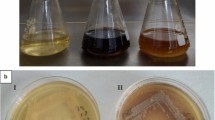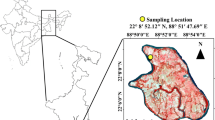Abstract
In the present study, extracellular synthesis of iron oxide nanoparticles (IONPs) was achieved using Aspergillus japonicus isolate AJP01. The isolate demonstrated its ability to hydrolyze the precursor salt solution, a mixture of iron cyanide complexes, under ambient conditions. Hydrolysis of these complexes released ferric and ferrous ions, which underwent protein-mediated coprecipitation and controlled nucleation resulting in the formation of IONPs. Transmission electron microscopy, selected area electron diffraction pattern, energy dispersive spectroscopy and grazing incidence X-ray diffraction analysis confirmed the mycosynthesis of IONPs. The synthesized particles were cubic in shape with a size range of 60–70 nm with crystal structure corresponding to magnetite. Scanning electron microscopy analysis revealed the absence of IONPs on fungal biomass surface, indicating the extracellular nature of synthesis. Fourier transform infrared spectroscopy confirmed the presence of proteins on as-synthesised IONPs, which may confer their stability. Preliminary investigation indicated the role of proteins in the synthesis and stabilization of IONPs. On the basis of present findings, a probable mechanism for synthesis of IONPs is suggested. The simplicity and versatility of the present approach can be utilized for the synthesis of other nanomaterials.












Similar content being viewed by others
References
Arruebo M, Fernández-Pacheco R, Ibarra MR, Santamaría J (2007) Magnetic nanoparticles for drug delivery. Nano Today 2:22–32. doi:10.1016/S1748-0132(07)70084-1
Barclay M, Hart A, Knowles CJ, Meeussen JCL, Tett VA (1998) Biodegradation of metal cyanides by mixed and pure cultures of fungi. Enzyme Microb Technol 22:223–231. doi:10.1016/S0141-0229(97)00171-3
Bharde A, Rautaray D, Bansal V, Ahmad A, Sarkar I, Yusuf SM, Sanyal M, Sastry M (2006) Extracellular biosynthesis of magnetite using fungi. Small 2:135–141. doi:10.1002/smll.200500180
Bhargava A, Jain N, Panwar J (2011) Synthesis and application of magnetic nanoparticles: a biological perspective. In: Dhingra HK, Jha PN, Bajpai P (eds) Current topics in biotechnology and microbiology: recent trends. Lap Lambert Academic Publishing AG & Co Kg, Colne, pp 117–155
Dhillon GS, Brar SK, Kaur S, Verma M (2011) Green approach for nanoparticle biosynthesis by fungi: current trends and applications. Crit Rev Biotechnol 32:49–73. doi:10.3109/07388551.2010.550568
Dumestre A, Chone T, Portal J, Gerard M, Berthelin J (1997) Cyanide degradation under alkaline conditions by a strain of Fusarium solani isolated from contaminated soils. Appl Environ Microbiol 63:2729–2734
Durán N, Marcato P, Durán M, Yadav A, Gade A, Rai M (2011) Mechanistic aspects in the biogenic synthesis of extracellular metal nanoparticles by peptides, bacteria, fungi, and plants. Appl Microbiol Biotechnol 90:1609–1624. doi:10.1007/s00253-011-3249-8
Ebbs S (2004) Biological degradation of cyanide compounds. Curr Opin Biotechnol 15:231–236. doi:10.1016/j.copbio.2004.03.006
Fedlheim DL, Foss CA (2001) Metal nanoparticles: synthesis, characterization, and applications. CRC Press, Boca Raton
Gade A, Ingle A, Whiteley C, Rai M (2010) Mycogenic metal nanoparticles: progress and applications. Biotechnol Lett 32:593–600. doi:10.1007/s10529-009-0197-9
Gibbs CR (1976) Characterization and application of ferrozine iron reagent as a ferrous iron indicator. Anal Chem 48:1197–1201. doi:10.1021/ac50002a034
Glass NL, Donaldson GC (1995) Development of primer sets designed for use with the PCR to amplify conserved genes from filamentous ascomycetes. Appl Environ Microbiol 61:1323–1330
Jain N, Bhargava A, Majumdar S, Tarafdar JC, Panwar J (2011) Extracellular biosynthesis and characterization of silver nanoparticles using Aspergillus flavus NJP08: a mechanism perspective. Nanoscale 3:635–641. doi:10.1039/C0NR00656D
Jain N, Bhargava A, Tarafdar JC, Singh SK, Panwar J (2013) A biomimetic approach towards synthesis of zinc oxide nanoparticles. Appl Microbiol Biotechnol 97:859–869. doi:10.1007/s00253-012-3934-2
Jogler C, Lin W, Meyerdierks A, Kube M, Katzmann E, Flies C, Pan Y, Amann R, Reinhardt R, Schüler D (2009) Toward cloning of the magnetotactic metagenome: identification of magnetosome island gene clusters in uncultivated magnetotactic bacteria from different aquatic sediments. Appl Environ Microbiol 75:3972–3979. doi:10.1128/AEM.02701-08
Jun YW, Seo JW, Cheon J (2008) Nanoscaling laws of magnetic nanoparticles and their applicabilities in biomedical sciences. Acc Chem Res 41:179–189. doi:10.1021/ar700121f
Komeili A (2007) Molecular mechanisms of magnetosome formation. Annu Rev Biochem 76:351–366. doi:10.1146/annurev.biochem.74.082803.133444
Laemmli UK (1970) Cleavage of structural proteins during the assembly of the head of bacteriophage T4. Nature 227:680–685. doi:10.1038/227680a0
Laurent S, Forge D, Port M, Roch A, Robic C, Vander Elst L, Muller RN (2008) Magnetic iron oxide nanoparticles: synthesis, stabilization, vectorization, physicochemical characterizations, and biological applications. Chem Rev 108:2064–2110. doi:10.1021/cr068445e
Lowry OH, Rosebrough NJ, Farr AL, Randall RJ (1951) Protein measurement with the folin phenol reagent. J Biol Chem 193:265–275
Macdonald IDG, Smith WE (1996) Orientation of cytochrome c adsorbed on a citrate-reduced silver colloid surface. Langmuir 12:706–713. doi:10.1021/la950256w
Njagi EC, Huang H, Stafford L, Genuino H, Galindo HM, Collins JB, Hoag GE, Suib SL (2010) Biosynthesis of iron and silver nanoparticles at room temperature using aqueous sorghum bran extracts. Langmuir 27:264–271. doi:10.1021/la103190n
Noguez C (2007) Surface plasmons on metal nanoparticles: the influence of shape and physical environment. J Phys Chem C 111:3806–3819. doi:10.1021/jp066539m
O’Donnell K, Nirenberg H, Aoki T, Cigelnik E (2000) A multigene phylogeny of the Gibberella fujikuroi species complex: detection of additional phylogenetically distinct species. Mycoscience 41:61–78. doi:10.1007/BF02464387
Parikh RY, Ramanathan R, Coloe PJ, Bhargava SK, Patole MS, Shouche YS, Bansal V (2011) Genus-wide physicochemical evidence of extracellular crystalline silver nanoparticles biosynthesis by Morganella spp. PLoS ONE 6:e21401. doi:10.1371/journal.pone.0021401
Patil S, Sandberg A, Heckert E, Self W, Seal S (2007) Protein adsorption and cellular uptake of cerium oxide nanoparticles as a function of zeta potential. Biomaterials 28:4600–4607. doi:10.1016/j.biomaterials.2007.07.029
Riemer J, Hoepken HH, Czerwinska H, Robinson SR, Dringen R (2004) Colorimetric ferrozine-based assay for the quantitation of iron in cultured cells. Anal Biochem 331:370–375. doi:10.1016/j.ab.2004.03.049
Schnurer J (1993) Comparison of methods for estimating the biomass of three food-borne fungi with different growth patterns. Appl Environ Microbiol 59:552–555
Sherman DM, Waite TD (1985) Electronic spectra of Fe (super 3+) oxides and oxide hydroxides in the near IR to near UV. Am Mineral 70:1262–1269
Simpson RJ (2004) Purifying proteins for proteomics: a laboratory manual. Cold Spring Harbor Laboratory Press, New York
Sun YK, Ma M, Zhang Y, Gu N (2004) Synthesis of nanometer-size maghemite particles from magnetite. Colloids Surf A 245:15–19. doi:10.1016/j.colsurfa.2004.05.009
Takekiyo T, Wu L, Yoshimura Y, Shimizu A, Keiderling TA (2009) Relationship between hydrophobic interactions and secondary structure stability for trpzip β-hairpin peptides. Biochemistry 48:1543–1552. doi:10.1021/bi8019838
Teja AS, Koh PY (2009) Synthesis, properties, and applications of magnetic iron oxide nanoparticles. Prog Cryst Growth Charact Mater 55:22–45. doi:10.1016/j.pcrysgrow.2008.08.003
Wang C, Zhang Y, Seng HS, Ngo LL (2006) Nanoparticle-assisted micropatterning of active proteins on solid substrate. Biosens Bioelectron 21:1638–1643. doi:10.1016/j.bios.2005.07.008
White TJ, Bruns T, Lee S, Taylor J (1990) Amplification and direct sequencing of fungal ribosomal RNA genes for phylogenetics. In: Innis MA, Gelfand DH, Sninsky JJ, White TJ (eds) PCR protocols a guide to methods and applications. Academic Press, San Diego, pp 315–322
Williams M (1997) The Merck Index, 12th Edition. CD-Rom Version 12.1. Drug Dev Res 41:108–108. doi:10.1002/(SICI)1098-2299(199706)41:2<108::AID-DDR9>3.0.CO;2-L
Wu Z, Neaton JB, Grossman JC (2008) Quantum confinement and electronic properties of tapered silicon nanowires. Phys Rev Lett 100:e246804. doi:10.1103/PhysRevLett.100.246804
Yang T, Li Z, Wang L, Guo C, Sun Y (2007) Synthesis, characterization, and self-assembly of protein lysozyme monolayer-stabilized gold nanoparticles. Langmuir 23:10533–10538. doi:10.1021/la701649z
Acknowledgments
This research was financially supported by the Indian Council of Agricultural Research, Government of India under the National Agricultural Innovation Project scheme (NAIP/C4/C-2032). Facilities provided by the Chonbuk National University, Jeonju, Republic of Korea, Advanced Instrumentation Research Facility, Jawaharlal Nehru University, New Delhi, India and Birla Institute of Technology and Science, Pilani, India are gratefully acknowledged. Arpit Bhargava and Navin Jain are thankful to the Indian Council of Agricultural Research and Council of Scientific and Industrial Research, Government of India, respectively, for providing research fellowship.
Author information
Authors and Affiliations
Corresponding author
Additional information
Special Issue Editors: Mamadou Diallo, Neil Fromer, Myung S. Jhon
This article is part of the Topical Collection on Nanotechnology for Sustainable Development
Electronic supplementary material
Below is the link to the electronic supplementary material.
Rights and permissions
About this article
Cite this article
Bhargava, A., Jain, N., Barathi L., M. et al. Synthesis, characterization and mechanistic insights of mycogenic iron oxide nanoparticles. J Nanopart Res 15, 2031 (2013). https://doi.org/10.1007/s11051-013-2031-5
Received:
Accepted:
Published:
DOI: https://doi.org/10.1007/s11051-013-2031-5




